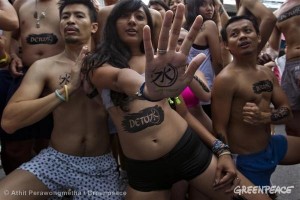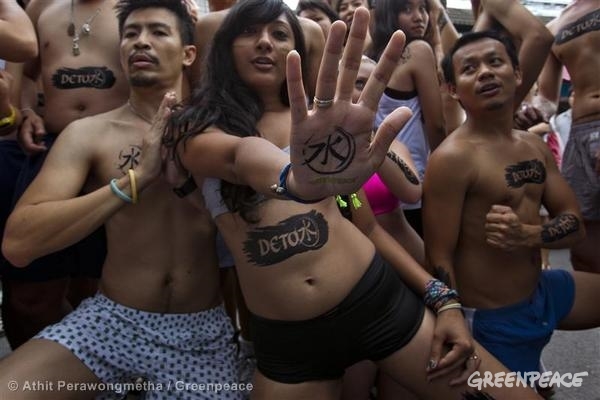The Detox Catwalk – Greenpeace launches a new type of fashion brand catwalk
The Detox catwalk
Greenpeace launched the Detox Catwalk, „an interactive online platform assessing the progress made by major clothing companies towards a toxic-free future“[1]
Greenpeace says “The Detox Catwalk assesses how committed companies have performed against key criteria; these include how they are working to eliminate known hazardous chemicals from their products and processes, and what steps they are taking towards full supply chain transparency.“

According to the Detox Catwalk,
DETOX LEADERS are Benetton, C&A, Coop Switzerland, Esprit, Fast Retailing (Uniqlo), G-Star Raw, H&M, Inditex (Zara), Levi Strauss, Limited Brands (Victoria’s Secret), Mango, Marks & Spencer, Puma and Valentino.
DETOX GREENWASHERS are adidas, Li-Ning and Nike.
DETOX LAGGARDS are Giorgio Armani, Bestseller, Only the Brave, Gap, Metersbonwe, PVH Group (Calving Klein, Tommy Hilfiger) and Vancl.
The following table shows the rating in the Detox catwalk and some of the key criteria which caused the ranking. The list includes ZDHC brands (* indicates founding member of ZDHC) and non members as well. ZDHC was formed as a response to the Greenpeace Detox campaign in 2011.
While looking at the table, commitment to transparency and disclosure of discharge data to a global online platform was a main criteria to be in the leaders camp. But it is also clear that within the leaders, some brands have given even further commitments, such as Marks & Spencer and H&M.
| Catwalk Detox rating | Companies / Brands | Greenpeace judgment[2] | Disclose discharge data on online platform | Detox commitment outside ZDHC[3] | ZDHC members[4] since | |
| Leaders | Benetton (Sisley, Playlife) |
case studies, restricted substance list, APEO report„has shown its true, trend-setting colours“ | x | 2013 | ||
| C&A | PFCs elimination ahead of schedule,“walking the Detox talk, matching its words with concrete actions“ | X | 2011* | |||
| Coop | immediate phase out of PFC and APEO“remains true to its winning form, staying ahead of the game when it comes to toxic-free fashion“ | X | 2013 | |||
| Uniqlo (Fast Retailing) | “has proven itself to be anything but casual when it comes to Detox” | X | 2013 | |||
| Esprit | “has the potential to become a true Detox leader” | X | 2012 | |||
| G-Star Raw | “on the road to becoming a Detox hero“” | X | 2012 | |||
| H&M | Proactive plan to phase out by 2014, ahead of ZDHC schedule„matching its commitment with fashion-forward action.“ | X | 2011* | |||
| Inditex (Zara, Massimo Dutti) | “Inditex is walking the talk and proving itself to be a Detox trendsetter” | X | 2012 | |||
| Levi Strauss & Co. | “Levi’s is following through on its promise to go forth and Detox.“ ” | X | 2012 | |||
| Limited Brands (Victoria´s Secret, La Senza) | “is revealing itself to be a fashion conscious Detox leader” | x | 2013 | |||
| Mango | proactive in PFC elimination plan,„ acting as a Detox trendsetter leading the way to fashion without pollution“ | x | 2012 | |||
| Marks & Spencer | proactive in PFC and APEO elimination, case study on substitution of phthalates in childrenwear,„taking important first steps down the road to toxic-free fashion“ | x | 2012 | |||
| Puma | proactive in implementation of APEO ban „Puma sits amongst the top cats when it comes to Detoxing our clothes“ | x | 2011* | |||
| Valentino Fashion Group | “best testing technology to verify zero”, elimination of PFCs ahead of schedule, “Valentino has shown its competitors that toxic-free fashion shouldn’t be a luxury.“ | x | 2013 | |||
| Green- washers | LiNing | “Lack of action shows significant credibility gap” | 2011* | |||
| adidas | „adidas presents itself as a fashion-forward leader. In reality, adidas has become an obstacle to progress by lowering the level of Detox ambition“ | 2011* | ||||
| Nike | “The company has no credible plan to eliminate priority hazardous chemicals“. | 2011* | ||||
| Laggards | Giorgio Armani | No further detailed assessment, according to Greenpeace“uncommitted toxic addicts that refuse to take responsibility for their toxic trail and have yet to make a credible, individual Detox commitment.“ | ||||
| Bestseller | ||||||
| Only the Brave (Diesel) | ||||||
| Gap (Banana Republic, Old Navy,..) | 2013 | |||||
| Metersbonwe | ||||||
| PVH (Calvin Klein, Tommy Hilfiger) | 2013 | |||||
| Vancl | ||||||
| Not rated | Jack Wolfskin | 2012 | ||||
| New Balance Athletic Shoe |
2013 | |||||
The online platform is ICE,[5] hosted in China. It is incredibly slow and in the present form a tedious exercise to deal with it.
Depending on the data, it will be interesting in the future to follow up how the brands deliver against the commitment to disclose data.
For companies like adidas and Nike, founding members of ZDHC, the classification as DETOX GREENWASHERS may come as a surprise.
Greenpeace says „The Detox Catwalk reveals sportswear giants Nike, adidas and Li Ning as Greenwashers that have failed to follow through on their commitments to clean up their toxic habits. The Catwalk shows that these companies continue to hide their collective inaction behind paper promises and industry working groups, while competitors“
Nike and adidas do not accept the charge.
Adidas responded “the criticism makes no sense…..the adidas Group is globally recognized as a leader in environmental sustainability…. ranked by the Institute of Public and Environmental Affairs, a Greenpeace partner, as one of the four top performing brands in our industry in China.” [6]. The company pointed to its own Restricted Substances Policy[7] for product materials that prohibit the use of chemicals considered as harmful or toxic, as well as its Health & Safety Guidelines, Environmental Guidelines and the Guide to Best Environmental Practices[8] that set standards for suppliers on handling and disposing chemicals.
Nike, said it has taken proactive steps to phase out “long-chain C8-based perfluorinated chemicals that provide water repellency and durability in high performance outdoor products“, and also pointed to the „Nike Materials Sustainability Index and its Making app that aims to steer designers toward environmentally sound materials“[9].
The ZDHC programme now has 16 brand members, now including PVH, Gap, Limitedbrands as well as the European outdoor group and German fashion as latest additions[10].
ZDHC an ineffective smokescreen?
Greenpeace considers ZDHC as a „collective umbrella…..promoting a smokescreen of tools and pilot projects“.
The environmental pressure group says „Greenwashers like Nike continue to use the ineffective Zero Discharge of Hazardous Chemicals (ZDHC) industry group as a smokescreen to mask their lack of individual action and ambition to clean up our clothes“.
Greenpeace stresses the point that additional individual corporate action is required.
We are not totally surprised, as we have reported earlier about some critical the issues related to the ZDHC programme[11]. Since then it seems it has not really changed, and the lack of transparency and lack of involvement of independent expertise are still critical issues.
Under ZDHC, a benchmark study has been initiated by C&A, G-Star and H&M (version of Februray 2013)[12]. The study has been carried out at factories in China (3 units in Jiangsu), Bangladesh (5 units in Dhaka) and India (3 units in Haryana, Uttar Pradesh and Karnataka) during 2012. Tests were carried out on 11 chemical substance groups defined under ZDHC as critical and subject to phase out by 2020. Later an extended report was put to the ZDHC website[13], covering 20 sites in China (8), Bangladesh (5) and India (3), Taiwan (3) and Vietnam (1).
We see some issues in the methodology of both reports which undermine their credibility. It would be beyond the scope of this article to discuss details of these reports; this can be covered separately. But for now, the good news is some retailers are talking some kind of action, and this is a step in the right direction.
Moreover, judging from many production recipes in the textile industry which we have seen over the years, the quality standards and specifications of the laggards groups are behind the companies in the leaders group, therefore the lower ranking here is not totally surprising for industry insiders. But having said that, it is remarkable that companies such as Nike and adidas who have very stringent quality specifications in the industry, surprisingly did not qualify for the leaders camp. Therefore, the negative judgment on Nike and adidas is the real story of this Detox catwalk.
 Where are the others?
Where are the others?
It should be noted that many of the world´s largest fashion retailers are not members of ZDHC, nor have they committed to Detox. The ZDHC / Detox brands have exposed themselves to a critical review, but they represent only a fraction of the total fashion and apparel market, while many global players, discounters and local players have not committed and are not included either in the Detox catwalk.
The ones who have committed did so after Greenpeace have put enormous pressure on them[3]. But there is still a long way to go to reach the world´s largest fashion & apparel companies.
The missing ones include retailers / brands such as Walmart, Target, Macy´s, Woolworth, Kohl´s, JC Penney, Liz Claiborne, Nordstrom, Polo Ralph Lauren, Prada, Dolce & Gabbana, LVMH (Bvlgari, Louis Vuitton) , Burberry , Brooks Brothers, Land´s End, , Peek & Cloppenburg, Hugo Boss, Karstadt, Otto, Tschibo, Marc O’Polo, Topshop, Topman, Abercrombie & Fitch (Hollister), Primark or Forever 21, just to mention a few.
Impact of the Greenpeace Detox campaign
But eventually, the consumer, not Greenpeace, is the judge that matters for the fashion brands.
So far, the Detox campaign has not reached the awareness of the broader public and mass media coverage has been very limited. Apart from some fashion blogs[14] and online versions of critical newsmagazines[15], the campaign has not reached the general public. If people on the street would be interviewed whether they knew about the awareness and impact of Detox, probably 99% would probably respond they never heard about it. In other words, the ZDHC “smokescreen” has been effective.
In the present political debate in the media retailers, especially discounters, are frequently under pressure in relation to their Bangladesh manufacturing operations and their labour conditions[16], for example kik in Germany[17].
But this may change anytime. It only needs another scandal to be taken up by the mass media. We all remember what happened when dioxine was found in eggs. Retailer better take serious action now to be prepared when the real storm begins.
Commercial viability
For the textile processors, implementing Detox will cost money, investments for effluent treatment, better equipment and higher cost for dyes & chemicals. People involved with the early steps of implementing zero discharge complain about the lack of commercial viability. Eventually retailers and traders will have to accept higher cost in their supply chain.
From the market feedback we have received, not everybody seems to be prepared to accept this. Retailers, respectively their commercial buying organisations, and most textile processing houses are very negative in accepting higher cost of their operations, unless they can sell their products for higher prices. Most players in the market, however, say this is very unlikely and hardly dare to ask for price increases. There is a likely scenario that Detox pressure will consolidate the textile processing industry and move on to even cheaper places, compensating higher cost for Detox by even cheaper labour.
Retailers have created a globalised complexity in the textile supply chain, while imposing enormous cost pressure on the textile processing industry. The primary driver behind this was cost savings, while it killed substantial parts of the textile and dyes & chemicals industry in the traditional markets. Now they are dealing with a fragmented supply chain, with thousands suppliers in China, India, Pakistan and Bangladesh, and have to manage the complexity. Convincing the suppliers that compliance with zero discharge, besides giving cheap prices, is now a condition for business, will be a exiting exercise.
There is need for large scale education to raise awareness for the issues, across the supply chain, starting at retailers themselves and ending at the textile manufacturers.
Outlook
We are preparing a series of papers dealing with the background of APEOs, a substance class which is in focus by the ZDHC and Detox.
We are also preparing training sessions and webinars to educate interested individuals on the scientific and technical backgrounds of Detox issues in textile processing. Inquiries can be sent to training@stepchange-innovations.com.
[2] Greenpeace website: The Detox catwalk
[4] roadmaptozero.com
[5] IPE Online platform
[10] ZDHC Third Quarter progress report
[11] StepChange Innovations blog articles covering detox and ZDHC: https://blog.stepchange-innovations.com/tag/zdhc/
[13] website roadmaptozero.com , addendum




